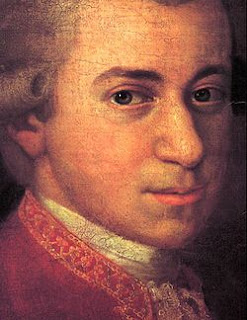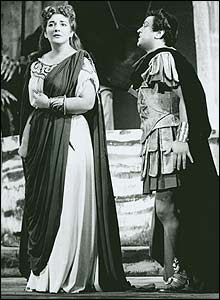
What type of music is most typically pagan?
Not something you get asked every day, but I would guess that, Inkubbus Sukkubus fans aside, most of you would go for folk music. With its associations with camp fires, smoky pubs and the film The Wicker Man, its bawdiness, hints of ancient wisdom and tales of merry happenings all-in-a-month-of-May, it probably represents where most Pagans are coming from.
However, if you were to trot down to your local HMV and look for myth and magic amongst the CDs there, you’d probably have the most success in the classical music section. If you’ve heard the music from the films The Lord of the Rings or Harry Potter, then you’ll know that sword and sorcery is something that classical composers know how to do.
But could opera be considered pagan? Normally associated with overweight, overwrought and overpaid performers, opera doesn’t have a great image outside of the cultural elite. But all opera really is is telling stories in music and song, which is a tradition that goes back to the days when our pagan ancestors were in short trousers. What’s more, some of the greatest composers in the history of opera used pagan themes for their works, so even if Pagan music lovers aren’t listening to opera, millions of opera fans are listening to pagan music. So here I go with the pagan highlights from the history of opera, starting with someone I’m sure you’ve all heard of.
Wolfgang Amadeus Mozart (1756 – 1791)

Opera was invented by the Italians, and at first things were fairly light hearted. However by the late eighteenth century the Germans had moved in on the act, and they took things a little more seriously. Up until this point opera had been ‘pagan’ only in so far as it extolled the virtues of wine, women and song, and occasionally ventured into Greek myth. However a certain Austrian child prodigy was to change that.
Wolfgang Amadeus Mozart is the big name in late eighteenth century music. His first mention in our story comes in 1787 when he unveiled his womanising anti-hero Don Giovanni, who after racking up two thousand and sixty five notches in the bedpost, eventually gets his comeuppance when he goes for one virgin too many. Cloaked, nocturnal, lecherous and ultimately hell-bound, he may well have been the inspiration for Dracula and all those other charming blood-suckers up to and including Buffy’s friend, Angel.
However Mozart’s main pagan credentials come from his last opera The Magic Flute, first performed in1791. A story of bizarre initiation rituals set in a Temple of Isis and Osiris, Mozart cobbled together the plot from Masonic ritual and a set of tarot cards. But the best song he gives to the Queen of the Night, Isis herself, whose main contribution to the show is her frenetic Revenge Aria. Female opera singers had always been known as divas, which is Latin for Goddess, but in the Queen of the Night The Goddess had finally arrived on stage in person, sadly just as Mozart himself shuffled off it.
Vincenzo Bellini (1801-1835)

This was all very well as far as it went, but it wasn’t what most of us would consider real paganism. Come the early nineteenth century though there was something of a Celtic revival going. Men in Egyptian style robes started to appear at Stonehenge for the Solstice, and some poets started churning out passable imitations of Bardic verse.
Meanwhile in rural Sicily, a lad called Vincenzo Bellini had developed a crush on a posh bird who lived near him. Unfortunately he was too poor for her father to allow her to marry him, so he went off to the big city to write operas. They turned out to be smash hits and he became so rich and famous that the lady’s father eventually consented to their marriage.
Unfortunately by this time Bellini had got a taste for the limelight and he completely forgot about his childhood sweetheart. The smart set of Milan and Paris always considered him something of a country bumpkin though, partly because of his habit of intoning spells to ward off the evil eye as he wandered about, but they certainly liked his music. “Opera should make you weep and die,” he would cheerfully say. In true romantic tradition Bellini went around being miserable, breaking hearts (male as well as female - allegedly) and knocking out hit operas.
In 1831 he decided to jump on the pagan revival bandwagon for his third opera, Norma. Norma is the chief Druid in a part of Gaul where the locals have decided that they don’t really want an aqueduct and are starting to ask “what have the Romans ever done for us?” This being opera, though, Norma’s domestic life is anything but straightforward. She is secretly married to the Roman governor Pollione, who is in turn secretly knocking off Adalgisa, one of the younger priestesses. When she finds out Norma is a little cross, to put it mildly. First she considers killing her children, and then Adalgisa, before finally offering herself as a sacrifice to their God, Irminsul.
Irminsul is a rather odd name for a Celtic God. The word is Anglo-Saxon for ‘great pillar’ and usually refers to the great World Tree of Northern Mythology. Bellini would appear to have had a slight problem with Celtic names. Norma, a Druid Priestess? And what are we supposed to make of Adalgisa? Is she named after a type of pain killer?
Bellini’s words were actually written by fellow Italian Felice Romani. His influences can be traced back to Tacitus’ story of the German priestess Velléda who led a revolt against the Romans, and the Greek myth of Medea, a priestess of the moon-goddess who betrayed her people to help Jason get the Golden Fleece. The portrayal of the Druids in the opera, as bloodthirsty but enlightened, owes much to the concept of the Noble Savage which was then popular thanks to the writing of Rousseau and others. Contemporary politics may also have come into the plot. The Gauls’ simmering resentment against the Roman occupation could be a reference to the then state of Italy, occupied by the Austrian and French armies, and not yet an independent country.
But back to the music. Bellini wrote his music slowly, and this shows in the long flowing songs of the opera. His style was known as bel canto, which directly translates as ‘beautiful singing’. This means that Bellini keeps the instrumentals to a minimum and makes the singers do all the hard work, labouring over every word to make their point. Apparently it’s all quite poetic too, but as I can’t speak a word of Italian I’ll have to take that on trust. It does sound good though, especially the aria Casta Diva (‘pure goddess’), Norma’s song for peace, sung to the moon as she cuts the Golden Bough. You’ve probably already heard it, as it’s been used in the films The Bridges of Madison County and the recent A Midsummer Night’s Dream, amongst others.

True to form as a Romantic, Bellini died young, at the age of 33. Norma though has given him a measure of immortality, and has never ceased to be performed from then on. Despite being a challenging part for even the most talented singer, the role of Norma has always been popular as it provides a welcome break from the usual tragic-heroine-done-in-by-her-no-good-lover roles. Fittingly then for the most famous pagan priestess in opera history, it was the greatest soprano of the twentieth century, Maria Callas, who made the role her own. She put in over forty performances on stage, was recorded twice, and came to be regarded as the definitive Norma.
Modern Pagans owe something of a debt to Bellini and Romani. Not only did Marion Zimmer Bradley use the plot of Norma as the basis of the first of her Avalon series of books, but, as no less a personage than Professor Ronald Hutton has pointed out, the opera also marks something of a watershed in the history of the neo-pagan revival. Whilst the contemporary Druids of the time were male sun worshippers, Bellini and Romani had their Druidic grove led by a priestess and meeting at night to worship the Moon. It was to be over a century before Gerald Gardner was to popularise the same idea.
Part Two: Wagner

No comments:
Post a Comment